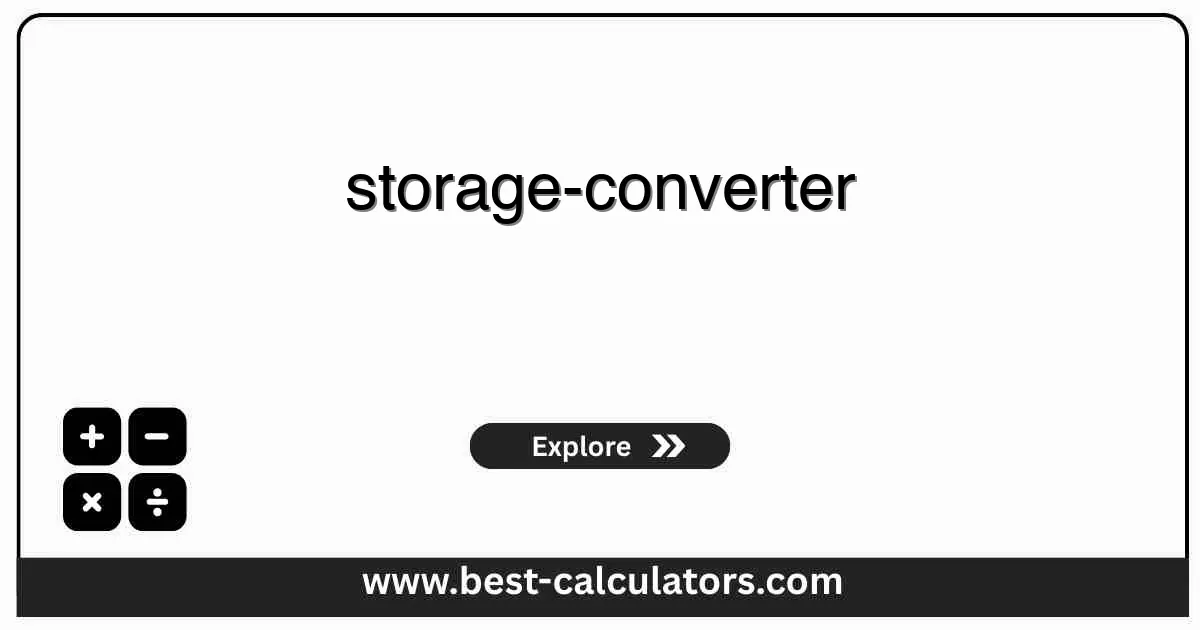Storage Converter - Convert Data Storage Units
Free storage converter to convert between bytes, KB, MB, GB, TB, PB, KiB, MiB, GiB, and TiB with exact decimal and binary unit math.
Storage Converter
Results
All conversions are computed from the exact byte value using precise SI (10-based) and IEC (2-based) multipliers. Use this to reconcile OS, vendor, and cloud storage figures.
What is a Storage Converter?
A storage converter is a precise technical tool that converts data between units like bytes, KB, MB, GB, TB, PB and their binary counterparts (KiB, MiB, GiB, TiB, PiB). It standardizes capacity values using exact byte multipliers so you can reconcile device labels, operating system reports, and cloud storage metrics without confusion.
This calculator works for:
- IT professionals & sysadmins — Normalizing storage specs across vendors, RAID groups, arrays, and backup targets.
- Developers & engineers — Converting limits, log sizes, database volumes, and object storage usage into consistent units.
- Everyday users — Understanding why a “1 TB” disk appears smaller and how much usable space is actually available.
To validate how long your converted storage amounts take to move across a network, use our Download Time Calculator to estimate precise transfer durations for backups and migrations.
To ensure your network capacity matches large storage workloads, explore our Bandwidth Calculator to size internet or LAN speeds for sync, replication, and cloud operations.
To estimate energy impact of disks, arrays, and storage servers, check our Server Power Calculator to align storage capacity with power and cooling budgets.
For planning cloud egress and data movement costs on top of your storage volumes, use our Data Transfer Cost Calculator to forecast monthly bandwidth spending.
To optimize how your storage supports remote workstations and displays, try our Screen Resolution Calculator to understand how media resolution and assets impact storage requirements.
How the Storage Converter Works
The calculator converts the input to bytes using the exact multiplier for the chosen unit, then derives all other units from that canonical byte value.
Key rules followed:
- Decimal units (SI): powers of 10 (e.g., 1 GB = 1,000,000,000 bytes).
- Binary units (IEC): powers of 2 (e.g., 1 GiB = 1,073,741,824 bytes).
- All visible values are formatted from the same underlying exact bytes number.
Key Storage Concepts Explained
Bytes vs Bits
Storage capacity is measured in bytes (B). Network throughput is in bits (b). 1 byte = 8 bits. Mixing them leads to errors when sizing backup windows.
Decimal vs Binary
Vendors often use decimal GB, while OS tools use binary GiB. Our outputs show both so capacity differences are transparent and mathematically justified.
Logical vs Physical Capacity
RAID, snapshots, parity, and thin provisioning mean logical capacity differs from raw bytes. Start with exact conversions before applying layouts.
Documentation Consistency
Using a consistent converter avoids unit drift across diagrams, runbooks, and contracts, reducing costly misinterpretations.
How to Use This Calculator
Enter the value
Type any non-negative number representing your storage amount.
Select the source unit
Choose KB/MB/GB/TB/PB or KiB/MiB/GiB/TiB/PiB based on how it is specified.
Adjust precision
Set decimal places for readable outputs without affecting exact math.
Review all units
Use the table to see the same capacity in SI and IEC units side by side.
Apply to planning
Use normalized bytes for RAID, backup, cloud, and compliance sizing.
Reset anytime
Click Reset to restore defaults and start a new conversion scenario.
Benefits of Using This Storage Converter
- • Exact math: Uses precise SI and IEC multipliers with no hidden approximations.
- • Consistency: Aligns OS reports, vendor specs, and cloud dashboards around bytes.
- • Clarity: Explains why capacities differ, reducing confusion in stakeholder communication.
- • Speed: Ultra-compact interface delivers all key units at a glance without scrolling.
Factors That Affect Your Storage Interpretation
1. Unit Standards
Mixing decimal GB with binary GiB leads to 7–10% discrepancies. Always check which standard is in use.
2. File System Overhead
File systems reserve space for metadata and structures, so usable capacity is less than raw bytes.
3. RAID & Redundancy
RAID1/5/6/10 and erasure coding consume part of raw capacity. Convert units first, then apply layout math.
4. Thin Provisioning & Snapshots
Logical allocations may exceed physical capacity. Accurate conversions help track true usage vs promises.

Frequently Asked Questions (FAQ)
Q: How does the storage converter work?
A: It converts your input into a canonical byte value using the exact multiplier for the selected unit, then derives all other units from that same byte count.
Q: What is the difference between KB and KiB?
A: KB = 1,000 bytes (decimal). KiB = 1,024 bytes (binary). Many systems mix them; this tool makes the distinction explicit.
Q: Why does my 1 TB drive show about 931 GiB?
A: 1 TB (decimal) is 1,000,000,000,000 bytes. In binary, dividing by 2³0 gives about 931 GiB. The converter reproduces this exactly.
Q: Can I rely on this for professional capacity planning?
A: Yes. It uses exact integer multipliers and avoids rounding until display, suitable for design documents and audits.
Q: Does it handle very large values safely?
A: Yes. Within JavaScript number limits, the logic keeps precision for realistic enterprise-scale capacities.
Q: Can I convert from binary units like GiB directly?
A: Yes. Select GiB, TiB, or PiB as the source; the tool normalizes to bytes and updates all related units instantly.